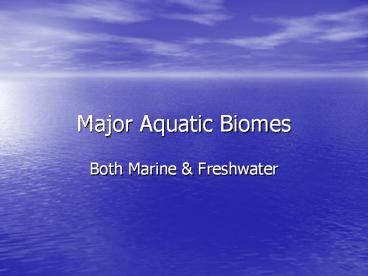Major Aquatic Biomes - PowerPoint PPT Presentation
Title:
Major Aquatic Biomes
Description:
Major Aquatic Biomes Both Marine & Freshwater Marine Ecosystems (high salt content) Vertical Stratification Benthic occurs on the bottom of a body of water ... – PowerPoint PPT presentation
Number of Views:150
Avg rating:3.0/5.0
Title: Major Aquatic Biomes
1
Major Aquatic Biomes
- Both Marine Freshwater
2
Marine Ecosystems (high salt content)
- Vertical Stratification
- Benthic occurs on the bottom of a body of water
- Pelagic occurs in the water column
- Epipelagic top layer where photosynthesis is
most productive - Mesopelagic mid-layer
- Euphotic Zone depth to which photosynthesis is
possible (usually 20 m) - Abyssal Zone deep water to 4,000m
- Hadal Zone extreme depth gt4,000m
- Littoral Zone shoreline
- Intertidal Zone area exposed at low tide
- Continental Shelf broad, relatively shallow
region along a continents coast - Temperature DECREASES with depth
- Cold water can hold more oxygen than warm water
3
Pelagic Marine Ecosystems
- Producers of the open ocean are phytoplankton
(floating algae) - Phytoplankton are fed on by Zooplankton (small
weakly swimming animals of many kinds) - Zooplankton are then fed upon by small fish and
shrimp, which in turn are eaten by larger fish,
and in turn, even larger fish.
4
Determining Factors in Pelagic Benthic
Ecosystems Checklist
- Ability of Sun to penetrate water
- Nature of the bottom substrate
- Water Temp
- Colder is usually better
- Amount and Type of Dissolved Nutrients
- Phosphorous
- Nitrogen
- Carbon
- Most prevalent in areas with flowing currents and
mouths of rivers carrying sediment
5
Benthic Marine Ecosystems
- In shallow areas, the sun can penetrate all the
way to the bottom, and have large communities of
living organisms. For egs., kelp forests, corals,
sponges, etc. - In the Abyssal Zone, the animals rely upon
marine snow for their food - Substrate Types
- Sand not good for plants, but good for
burrowing animals - Mud good for plants, but low in oxygen flow
- Rock good for algal growth
6
Coral Reefs
- Coral Reefs conversely require warmer waters
- Need clear water for maximum sun penetration
- Known as the most productive ecosystem in the
world - Used by fish for food, nurseries, hiding places,
etc. - One of the most endangered ecosystems on the
planet - Dynamite fishing
- Human interaction
- Pollution
7
Mangroves
- Prevent erosion
- Provide nursery sites and hiding spots
- Vulnerable to
- Human interaction
- Pollution
- Clear-cutting for fish farming
8
Estuaries A Unique Situation
- Estuary place where river meets ocean, i.e.
fresh meets salty (brackish) - Organisms are evolutionarily adapted to this low
salt content - Tends to trap sediment, thus preventing it (and
the pollution it contains) from reaching the open
ocean. - However, this same sediment will eventually fill
up the estuary, turning it into a marsh.
Ecological succession at its best!!!
9
Vertical Stratification in Freshwater
- Limnetic Zone portion of the water without
rooted vegetation - Riparian Zone vegetation growing on the banks
- Epilimnion warm upper layer mixed by wind and
warmed by the sun - Hypolimnion below the epilimnion colder layer
that doesnt experience much mixing - Mesolimnion boundary between the epilimnion and
hypolimnion
10
Wetlands
- Shallow ecosystems in which the land surface is
saturated or submerged at least part of the year. - Estimated that 1/3 of all endangered species
spend at least part of their lifetime in wetlands - Retain storm water and reduce flooding by slowing
the rate at which rainfall reaches rivers. As
this water is retained, it seeps into the ground,
replenishing the ground water supply - Filter runoff through bacteria and plant life
that take up the contaminants.
11
Swamp or Marsh???
12
Lakes and Ponds
- What vertical zones could be the same regardless
of whether youre talking about a lake or open
ocean? - Plants are a major source of biodiversity in
freshwater ecosystems. Visible plants in and
around freshwater called emergent plants, egs.
Cattails, waterlilies, bulrushes. - Plants that are completely under water are called
submerged plants, egs. Elodea - Shallow lakes and ponds are usually more
biologically productive. Why might this be? - Deeper, colder lakes are called oligotrophic
lakes because they are less biodiverse.
13
Eutrophication
- Productive ponds and lakes can remain this way
for only so long. Eventually, all things die.
The more organisms you have (plants animals),
the more decaying waste you have. - The more organic materials decay, the more oxygen
they use up. This is called biological oxygen
demand (BOD). - When it gets to the point where the BOD is so
high that there is no dissolved oxygen (DO) left
for the organisms that live there, we say that
eutrophication has taken place. Egs. Algal
blooms (the red tide from the bible) - Humans make the problem of eutrophication
(cultural eutrophication) worse by adding
nutrients, chemicals, trash, etc. to the water.
14
Streams Rivers
- Lots of similarities to lakes and ponds.
- However, water clarity is a major problem. Why
might this be? - However, there are many organisms in this
environment that have evolved specifically to
utilize this kind of debris as food. Egs.
Bacteria, fungi, bottom feeders
15
Human Disturbance
- Conversion of natural habitat for human uses is
the largest single cause of biodiversity loss,
both aquatic and terrrestrial!































